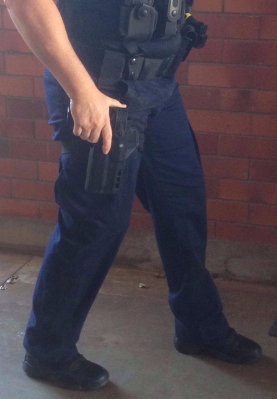
I’ve never had to draw my firearm in 20 years of service as a police officer.
I’ve been following the case of US police officer Mohamed Noor, who shot and killed Justine Damond after she approached his police car. The court proceedings received a bit of air-time in Australia due to Ms Damond being an Australian citizen. Also, the tragic facts of the case made for compelling subject matter.
As a police officer, I tried to put myself in Mr Noor’s position and think how I might have reacted. Night-time in a dark alleyway, a sudden noise, a figure at the side of the car.
Although I’ve been a police officer for twenty years, I’ve worked only in Australia, and there is no comparison. One crucial difference to policing in the two countries deeply impacts a situation like that – the prevalence of and attitude towards guns. That gun culture has a huge flow-on on effect to the way police approach their duties.
In twenty years, I have NEVER drawn my service weapon, except at training. I have only once been to a job where my partner has felt compelled to draw his weapon (I thought he over-reacted). From this, you can guess that I have never been confronted with a person armed with a weapon. I could count on one hand the number of times I have found a firearm at the scene after the offender is safely in cuffs.
I don’t know of any officer who wears a personal bullet proof vest. We have station-issue vests in different sizes which we put in the back of the police car. If we get sent to a job where there is a firearm involved, we stop before we get there and put the vest on. I can think of only three occasions I’ve worn it in earnest.
My experiences aren’t unusual. Guns on the street in Australia are unusual.
If I was confronted by a person in a dark alley, it wouldn’t occur to me that I might be ambushed. Sure, we’re taught that every situation is high risk or unknown risk. There is no such thing as low risk as you never know what is going to happen next. That said, I wouldn’t approach the job as if I may be randomly shot. A bang on the window would not have me reaching for my gun. That may be complacent and dangerous but, frankly, the odds are in my favour.
A Google search shows there were two police killed on duty in Australia in 2017. Of these, only one was shot. I had to go back to 2017 because there were zero shooting deaths of police in 2018 and 2019 to date. Nineteen police officers have been shot and killed in the line of duty in the USA so far this year (May 2019).
I can’t imagine what it would be like to have to assume everyone you deal with is armed. It would skew every decision you made every time you dealt with anyone.
I can’t imagine how much more difficult the challenging job of policing would be with the potential threat of firearms at every job.
I can’t put myself in Mr Noor’s shoes that night because I come from a completely different policing background.
I can’t imagine being a police officer in America. I can only hope Australia’s gun laws stay strict. I want to leave my gun in its holster for the next twenty years.
Buy ‘A Time to Run’ here.
I hope all countries should have a strict law against guns like Australia. I’m pretty sure it will lessen guns violence. Thanks for the interesting information.
LikeLike
Thanks. As both a police officer and a mother, I am grateful for Australia’s gun laws.
LikeLike